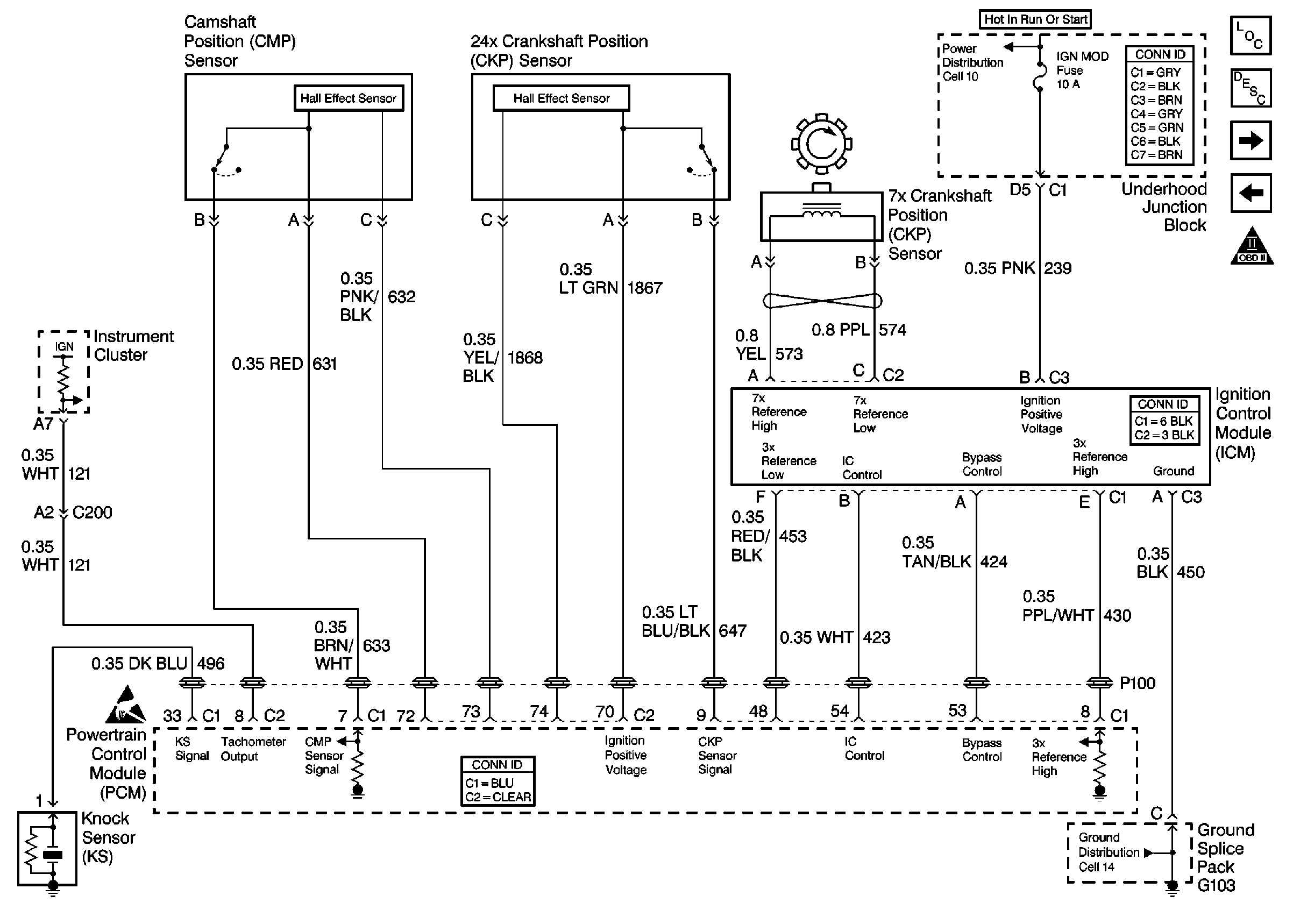Refer to Engine Controls Schematics
Cell 21: Ignition Controls

Circuit Description
The Ignition Control (IC) Module sends signals that the PCM requires for fuel control and spark advance calculations. At the start of engine crank the IC Module controls spark advance (Bypass mode.) When the second 3X reference pulse is recognized by the PCM, the PCM applies 5 volts to the Bypass circuit. The 5 volts on the Bypass circuit commands the IC Module to switch spark advance to PCM control (IC mode). At this time, the IC Module will remove the ground it has applied to the IC circuit. When the IC pulses are not grounded, the IC Module can use the IC pulses to control spark advance. A short in the IC circuit or an open or short to ground in the Bypass circuit will cause the PCM to monitor no IC pulses after the PCM has switched the Bypass circuit ON. The PCM will set DTC P1361 under either of these conditions. The engine may be started but will run on Bypass mode timing.
Conditions for Running the DTC
| • | Engine speed greater than 600 rpm. |
| • | No DTC P1351 set. |
Action Taken When the DTC Sets
| • | The PCM will illuminate the malfunction indicator lamp (MIL) during the second consecuitive trip in which the diagnostic has been run and failed. |
| • | If equipped with traction control, the PCM will command the EBTCM via the serial data circuit to turn OFF traction control, and the EBTCM will illuminate the TRACTION OFF lamp. |
| • | The PCM will store conditions which were present when the DTC set as Freeze Frame and Failure Records data. |
Conditions for Clearing the MIL/DTC
| • | The PCM will turn OFF the MIL during the third consecutive trip in which the diagnostic has been run and passed. |
| • | The History DTC will clear after 40 consecutive warm-up cycles have occurred without a malfunction. |
| • | The DTC can be cleared by using the scan tool. |
Diagnostic Aids
Check for the following conditions:
| • | Poor connection at PCM. Inspect harness connectors for backed out terminals, improper mating, broken locks, improperly formed or damaged terminals, and poor terminal to wire connection. |
| • | Damaged harness. Inspect the wiring harness for damage. If the harness appears to be OK, disconnect the IC Module, turn the ignition ON and observe a voltmeter connected between the IC circuit and battery positive voltage while moving connectors and wiring harnesses related to the IC Module. A change in voltage will indicate the location of the fault. |
Refer to Testing for Continuity , Intermittents and Poor Connections Diagnosis , Repairing Connector Terminals , and Connector Repairs in Wiring Systems.
Reviewing the Fail Records vehicle mileage since the diagnostic test last failed may help determine how often the condition that caused the DTC to be set occurs. This may assist in diagnosing the condition.
Step | Action | Value(s) | Yes | No |
|---|---|---|---|---|
1 | Did you perform the Powertrain On-Board Diagnostic (OBD) System Check performed? | -- | ||
2 | Is DTC P1362 also set? | -- | ||
3 |
Does the test lamp illuminate? | -- | ||
4 |
Does the test lamp illuminate? | -- | ||
5 | Repair short to voltage in the IC circuit. Refer to Wiring Repairs Did you complete the repair? | -- | -- | |
6 |
Does the test lamp illuminate? | -- | ||
7 | Repair the short to ground in the IC circuit. Refer to Wiring Repairs . Did you complete the repair? | -- | -- | |
8 |
Does the test lamp illuminate? | -- | ||
9 | Repair the short to ground in the BYPASS circuit. Refer to Wiring Repairs . Did you complete the repair? | -- | -- | |
10 |
Did you find and correct the condition? | -- | ||
11 |
Does the voltage toggle between the specified ranges? | 20mV-40mV 150mV-250mV | ||
12 | Replace the ICM. Refer to Ignition Control Module Replacement . Did you complete the replacement? | -- | -- | |
13 |
Important:: The replacement PCM must be programmed. Refer to Powertrain Control Module Replacement/Programming . Replace the PCM. Did you complete the replacement? | -- | -- | |
14 |
Does the DTC reset? | -- | System OK |
